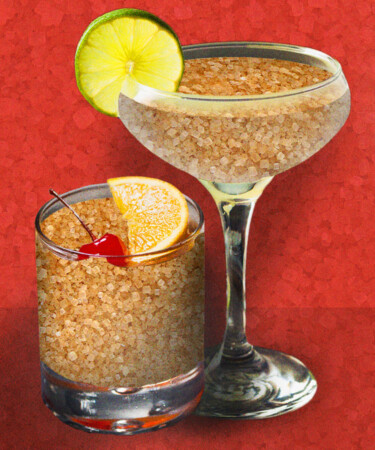Demerara sugar is a fabulously funky substance. Extracted from freshly pressed sugar cane and barely processed, its brown, chunky granules and crunchy texture make a spoonful of the stuff look like forbidden Grape Nuts. While it’s not recommended to eat Demerara as a breakfast cereal, it’s heartily endorsed by the bartending community as a vital ingredient in many cocktail creations.
Of course, it’s not surprising to find sugar in a mixed-drink recipe. Sugar has played a key role in bartending since the term “cocktail” was first associated with alcoholic beverages in the early 19th century. There’s a good reason for this: Sugar balances citrus and bitter flavors, enhances texture, and adds weight for optimal mouthfeel. But specifically calling for the use of Demerara in a new creation, an old school tiki drink, or a classic cocktail suggests there’s something about its usage that’s more intriguing than regular sugar’s almost utilitarian purpose. To find out what that is, and why so many drinks call for Demerara, VinePair chatted with Daniel Boothe, bar manager at the Tales of the Cocktail-nominated tiki and modern tropical cocktail bar Strong Water in Anaheim, Calif.
Demerara provides the expected elements to a cocktail that ordinary sugar does, either as a solid sugar or in its more common form as a syrup. But it also delivers something extra from a compositional standpoint that makes it a special ingredient. “Demerara adds a lot more richness, body, and complexity to a drink,” Boothe explains. “It adds these wonderful caramel and toffee notes to a cocktail. Adding these flavors to an Old Fashioned is heaven.”
The secret sauce behind Demerara’s captivating flavor is molasses, which is not in the ordinary sugar used to make conventional simple syrup. Boothe explains that during processing, the sweet, sticky substance becomes separated from the crystals that form granulated white sugar via centrifugal force. “White sugar is refined to the max,” he says. “It’s a bit of a crazy process.” While white sugar retains its sweetness, this process strips it of the additional flavor depth that molasses — and ultimately Demerara — brings to the table.
This added depth allows Demerara to bring extra flavor-driven complexity to the palate, but it also makes it particularly adept at reining in prominent components that may otherwise overpower a beverage. “If you’re building a cocktail with big, strong alcohol, you need a syrup that can stand up to its bold flavors,” Boothe explains. “A stirred, spirit-forward cocktail or a drink with an aged spirit will benefit from Demerara. At the same time, Demerara will still allow the spirit to shine.” The sweetener’s ability to subdue beastly beverages also makes it a no-brainer for boozy tiki classics and modern acidic tropical riffs. “Again, nice strong flavors work well with nice, strong sugars,” Boothe says.
But there’s a catch to fully harnessing Demerara’s magic. According to Boothe, it’s crucial to understand the correlation that exists between how much Demerara syrup goes into a cocktail and the syrup’s sugar to water ratio. A two-to-one ratio (two parts Demerara, one part water) will produce what’s sometimes referred to as rich Demerara — a fuller, rounder syrup than the standard one-to-one ratio — but less of it will be needed in a given drink. Eschewing this adjustment will throw the beverage out of balance. Boothe says mastering this sliding scale requires practice and a willingness to experiment, but it’s worth the effort because of what the fabulously funky substance can add to even the simplest of drinks. “You need to try a Daiquiri with Demerara,” he says. “It’s just so damn great.”
